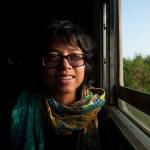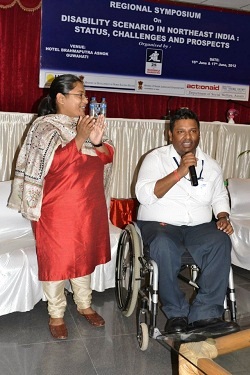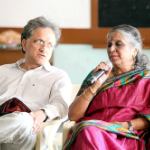"Thailand is the best country in the world" - I am told unabashedly by a friend who travels around the world frequently. Not an original idea going by the amount of literature that is produced by ex-pats living in Thailand claiming the same thing since the time before modernization of Thailand. And there is no bias in these expressions of euphoria in superlatives given how wonderfully hospitable the Thai people are. A splendidly polite culture which has managed to retain its niceties inspite of extreme consumerism and commercialization. I am a fan of the place too as I have expressed many times before.
My friend however has a singular reason for ranking Thailand as the top country and the only one in his list - Tom Yum Goong! I ask him why and I can barely hear his answer because of the slurping noise he makes over the huge bowl of the spicy thing at the 6th floor Food Court at MBK mall in Bangkok. Cooked with a generous dose of aromatic herbs, like lemon grass, galangal, lemon juice, kafir lime leaves, basil, super dose of chilli and juicy prawns, the spicy, tangy, flavourful soup does deserve to stand on the medal podium in any food Olympic. But to give it the one and only gold in the world is a bit biased I think. What about Mango sticky rice? And the tender grilled crabs? Or the crispy roasted pork belly? What about the steamed fish in lemon and chili sauce with fresh herbs? The rice cakes with peanut sauce? The octopus and sea weed salad? The shrimp and coconut curry cooked inside a tender coconut?
It is not for nothing that Bangkok is called the food capital of the world. The city hosts something around 2 million food joints! Every street in Bangkok has food stalls laden with an unbelievable variety of food. In terms of content, flavor, cooking style and presentation - the range is enormous.
Two things amazed me when I first came to Bangkok - the cleanliness and orderliness of the place and the number of people who seem to be eating at any point of time anywhere in the city. Somehow, the 2 million (random figure but surely close to the real thing!) eateries of this vast city seem to be full all the time. How do they eat so much? And what do they eat? From the crowded streets of Sukumvit, by the Chao Phriya River, along the strip bars of Patpong, amidst the fashion stalls of Siam square every second shop is a food stall and every second there is someone eating in them. My amazement was confirmed once more when I saw the co-operative canteen at the Chulalonkgkorn University.
When I first arrived at the university I was quite hungry. The hunger was caused as much by the all night journey I made from Guwahati via Kolkata as by my memories of Bangkok food releasing hormones responsible for causing hunger in a greedy being. I was however a little apprehensive. A traumatic young adulthood caused by bad hostel food has left deep scars. I remembered the watery dal, tasteless vegetables and burnt fish or meat as I walked to yet another university canteen of my life. But sometimes surprises can be very pleasant indeed. A wide hall of about 10000 sq ft had rows of wooden tables and benches. Sitting on them were hundreds of students eating intently from their plates and bowls. The aroma that filled the air doubled my hunger. It took me just a second to take in the rows of food stalls from where the food was coming. There are about 10 stalls. 2 sell fruits, juices, shakes, yoghurt, ice tea, deserts and such. The other 8 sell food. Each stall has 10-20 items of food displayed through a counter. Each one has a different collection. Using my advance mathematical skills, I quickly figured that there are about 120 food items on offer if I average it. Although my hungry mind wanted to immediately taste all 120, my stomach had to restrict. I ate only about 10 in the first meal. It cost me all of 100 baht which is on the highest side possible in the canteen. Normally a plate of rice with 1 meat, 1 fish and 1 vegetable dish will cost you around 30-35 baht.
I wanted to taste each and every item that was on offer in the canteen during my stay in Bangkok. An impossible task considering the items kept on changing everyday too! The first few weeks I tried to take photographs of every item I was eating so that I do not repeat any item twice. I also visited the canteen as many times as I could during the day. During these frequent visits here too I noticed how the canteen is full all the time and everyone is eating through the day.
Thai must be the widest cuisine in the world. Delicate flavours, sensuous textures, pungent odours, super hot chillies, unique processing, curious mixtures and favourable fusions have all come together to make Thailand the food capital of the world. The cuisine varies from province to province and has taken generous contributions from its neighbours. Malay Muslims, Burmese and Chinese have added their signatures into the cuisine. Thai food has also taken different avatars trying to please its 17 million visitors in that typically sweet Thai way. Take for example the Tom Yum. Although you will find Tom Yum anywhere in Thailand (really anywhere), the taste will be different in different places. In most Bangkok and other major touristy places coconut milk is added to make the super tangy and hot soup palatable to tourists. In smaller, interior places it does not contain coconut milk. Towards the South as the weather gets humid and hot, the soup gets tangier.
Although I started with a vengeance, in order to eat all the food that is there in Bangkok, it took me just about 10 days to realize I was setting myself an impossible goal. It is not only Thai food, Bangkok also has food from Burma, China, Vietnam, Cambodia, Laos, Malaysia, Bangladesh, Pakistan, India, Indonesia, Japan, Mexico, France, Germany, Italy, Spain, England, Ireland, Ethiopia, Egypt, Libya, Ghana, Congo, Iran, Iraq, Israel, Palestine, Jordan - did I leave any country out? All these and the night markets!
My other favourite places to eat at are Bangkok's many night markets. Every night as the sun sets, vendors will come with their innumerable wares and set up stalls. Around their stall on wheel they would set up a few tables and stools and there you have - little restaurants every step! Each of them spick and span and not a grain of rice out of plate. Every night when they finish they pick up their ware, pack the garbage, clean the place and leave only then. In one night market I had counted something around 300 such stalls excluding uncooked products like fruits and vegetables! The only downside to these fascinating food galaxies are that no matter how much you try to eat all they offer you will always end up feeling defeated. To think one can eat all that in a mere 3 months time is an audacity. I was punished sufficiently for showing this audacity with few extra kilos around my middle portion within a few days of being there.
Like our (the North-East and South East Asia) chinky eyes and kinky history there are some things common amongst what goes in the wok too. Sticky rice, a thing of pride and popular breakfast, found only in the Northeastern part of India is eaten all over South East Asia. On the streets of Bangkok you will find sticky rice mixed with banana, coconut and other kinds of fruit, wrapped in banana leaves and steamed to softness. It is served as a main course, to be made into small tight balls and popped into your mouth after dipping in the accompanying meat, fish and vegetable dishes.
The fried and roasted insects like crickets, beetles and few others I do not know the names of are found all over the city. The crunchy delights are supposedly high in protein. In many parts of Northeast India too they are a delicacy, served to only to special guests.
The fried and steamed frogs reminded me of the villages in southern Mizoram bordering Myanmar where I had tasted them few years earlier. The sweet water snails and crabs that are eaten in many places in the North-East are found more easily in the village markets than in the city joints but eaten with similar squeals of excitement.
Lai Xak (Thai spinach) which is eaten in abundance all over North-East is found very often in different dishes here. Lai xak is such a ubiquitous thing in the North-East that in the early years of my living in India, I could not believe you do not find that there. They did not even know such a leaf exists. I had found that very hard to digest.
In Thailand too they make pork with Lai Xak. Boiled in a very similar way. Bamboo shoot, dry and fermented fish, dry meat, fresh greens, many citrus fruit, banana flower, bhekuri tita - a small round green bitter vegetable, tree tomatoes, no turmeric, low salt, I did not have to miss home being in Bangkok.
The pork however is a little disappointing. The processed near white meat they serve you as pork is nothing compared to the straight from the pit, killed in the wee hours of the morning, three layered (skin, fat and meat), melt-in-your-mouth, most-beautiful-thing-in-the-world that we get in Northeast India. Ahem, have I just found one thing we have better than them? I know I could be killed for saying it, and it would be my fault if I am, I actually found Tom Yum in some places a lot like the Assamese dhonia dia bilahi masor tenga - sour tomato fish curry with fresh coriander.
Sadly for us though, the similarity once again stops somewhere before 11th century. What the Thais have done to their food is parallel only to what was done by the Europeans in the 18th and 19th century - revolution. Processing, packaging, presentation and service, the eating experience in Bangkok (and other parts of Thailand) can only be called a revolution. Using technology they have managed to simplify cumbersome traditional food like bamboo shoot and banana flowers into supermarket items. There are simple devices available that will peel a coconut, grind things to various consistencies, peel and cut difficult fruits like pineapple and jack fruit etc. Traditional ingredients for Thai food like lemon, grass, basil, kaffir lime leaf, galangal (a kind of ginger) and vegetables like pok choy, green brinjals, Thai spinach are grown in large quantities.
After feeding nearly 87 million people, including the 17 million tourists they receive every year, Thailand's food exports account for 10% of their total exports. The export industry consists mostly of packaged ingredients, vegetables, canned fruits and sea food products. All over the world, there is a high demand for Thai food as Thai cuisine becomes more and more popular. They have managed to modernize the food sector elevating it to an industrial level, providing employment and livelihood to many and still retain their identity through their own flavours. An admirable thing when I think about the fast food joints selling oily chowmein, dry burgers and onion filled momos back home.
The reason that I did not manage to eat all the food available on the streets of Thailand is as much the fault of their innumerability as it is the fact that I too have developed favourites in no time. No matter how much I tell myself I will be a true food warrior and march ahead without looking back, I keep on needing the comfort of the familiar once in a while. Apart from a dose of Tom Yum on a daily basis I blame Tom Sam - raw papaya salad, Tom Khao - boiled rice soup with vegetables and meat eaten mostly when sick but tastes delicious otherwise too, the insects fries, the steamed fish with lemon and chilly, crispy rice cakes served with peanut butter, roasted crab in black pepper sauce, crispy roasted pork, Yum Neoa - grilled beef salad, mango and sticky rice with coconut milk, Durian - the smelly fruit and differently flavoured bubble milk for coming on the way of my quest for attaining the end of Thai food. I am told there is a fault in the quest itself for trying to reach the end of Thai food is like trying to find the end of time or space. I would take the challenge up right now if all these food talk hadn't made me this hungry!







































